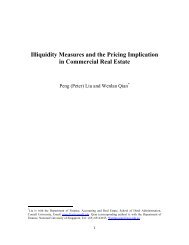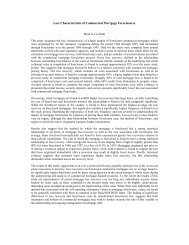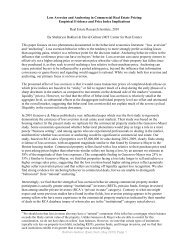Commercial Mortgage Delinquency, Foreclosure and Reinstatement
Commercial Mortgage Delinquency, Foreclosure and Reinstatement
Commercial Mortgage Delinquency, Foreclosure and Reinstatement
Create successful ePaper yourself
Turn your PDF publications into a flip-book with our unique Google optimized e-Paper software.
contemporaneous loan-to-value ratio <strong>and</strong> the interest rate were positive <strong>and</strong> significant. The debtcoverage ratio was not significant, but the value at loan origination was used, not thecontemporary value. The property type <strong>and</strong> the borrower type also had significant effects.V<strong>and</strong>ell argues that the significance of the borrower type is evidence that transaction costs havean influence on default.There has been a recent explosion in work on the empirical estimation of commercialmortgage default, including Ciochetti et al (2002), Ambrose <strong>and</strong> S<strong>and</strong>ers (2001), Archer et al.(2002), Chun <strong>and</strong> Deng (2002) <strong>and</strong> Goldberg <strong>and</strong> Capone (2002). These studies differ in theirdata sources, estimation technologies, set of independent variables <strong>and</strong> definition of default.The current study uses data from a single large commercial mortgage lender, as doesCiochetti et al. (2002), although they use a different, American firm. Other studies usecommercial mortgage backed securities data (Ambrose <strong>and</strong> S<strong>and</strong>ers (2001) <strong>and</strong> Chun <strong>and</strong> Deng(2002)) or multifamily mortgages (Archer et al. (2002) <strong>and</strong> Goldberg <strong>and</strong> Capone (2002)).The critical independent variable suggested by option theory is a measurement of theborrower’s equity, the loan-to-value ratio. Goldberg <strong>and</strong> Capone’s (2002) findings suggest thatcash flow considerations, measured as the debt coverage ratio, also play a role in default. Archeret al. (2002) <strong>and</strong> Ambrose <strong>and</strong> S<strong>and</strong>ers (2001) both confirm the lack of a relationship betweeninitial loan-to-value ratio <strong>and</strong> default, while Ciochetti et al. (2002) find that contemporaneousloan-to-value ratio <strong>and</strong> debt coverage ratio are significantly positive <strong>and</strong> negative, respectively.Other variables used as independent variables in these studies include borrower characteristics,property location <strong>and</strong> market conditions. This research is the first to consider the presence of aguarantee.In most of these studies, a mortgage is considered to be in default at the time when theloan terminates through foreclosure. 1But work by Ambrose <strong>and</strong> co-authors explicitly recognizethat default <strong>and</strong> foreclosure are not synonymous. In Ambrose <strong>and</strong> Capone (1996), costs <strong>and</strong>1 An exception is Archer et al. (2002) who define default as 90-days delinquent.4





